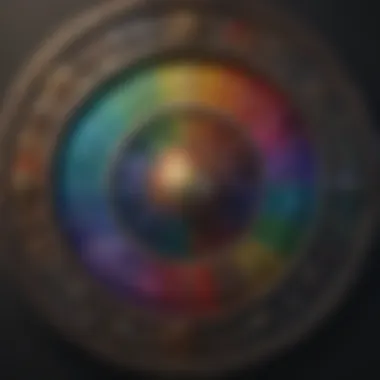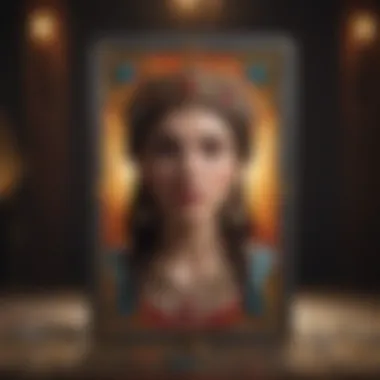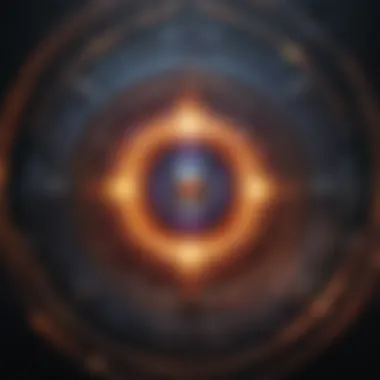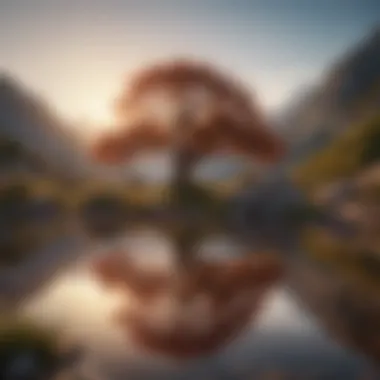Exploring the Influence of Color in Astrology and Tarot


Intro
Color influences much of human experience. In astrology and tarot, colors play a vital role in understanding energies and traits. Each zodiac sign resonates with specific colors that reflect personality traits, strengths, and potential weaknesses. Similarly, tarot cards embody different hues that enhance their meanings. This connection is crucial for practitioners looking to deepen their understanding of themselves and their interactions with the cosmos.
Characteristics of Each Zodiac Sign
Astrology defines twelve signs, each linked with color symbolism. These hues aid in interpreting personality traits and relationships. For instance:
- Aries: The vibrant red embodies courage and determination. Low spirit may cause outbursts and crankiness.
- Taurus: The soft green symbolizes stability and comfort. However, stubbornness may lead to hurdles in relationships.
- Gemini: Bright yellow reflects adaptability and intellect; yet, indecision often hinders their growth.
Understanding each sign helps in personal and interpersonal development. Learning these colors creates pathways for groups to explore cosmic energies effectively.
Daily, Weekly, Monthly Horoscopes
Color also plays a role in predictions for zodiac signs. Each horoscope segment highlights dominant shades influencing key areas:
- Aries: Embrace red for vitality when dealing with challenges this week.
- Cancer: Focus on calming blues during daily interactions.
- Sagittarius: Yellow shades can inspire creativity this month.
Talking about colors in horoscopes enhances interpretation and self-development via dependence on their qualities.
Love and Relationships Horoscopes
In romantic matters, color choice can impact compatibility. Each sign often has a color that can be cornerstones for relationships. For example:
- Leo and their bright persona attracted to creative shades, leading ventures in romance.
- Virgo: Subdued tones help establish security and calm. With understanding strains on relationships, this balance helps foster connection.
Enhancing love life through astrological color understanding brings fresh meanings toward personal unions.
How to Interpret Tarot Cards
In tarot, colors on cards are significant across the two groups: Major and Minor Arcana. Each color conveys unique themes and energies. Identification may go as such:
- Major Arcana: Tarot cards often glow via royal hues highlighting powerful messages.
- Minor Arcana: They feature diversity presenting energetic pathways for communities engaged.
- Key cards often relate with specific colors to drive intuitive understanding. Take The Fool, with its bright yellows, inviting new possibilities.
To build intuition:
- Reflect on diverse colors in each drawer sets.
- A personalized deck aids emotional engagement enhancing self-awareness through art.
Understanding Birth Charts
A birth chart contains details about a person's energetic signature and colors amplify readings deeply. Components include:
- Zodiac signs
- Houses
- Planets positions
People often confuse planets composed within frameworks expressing emotions directly related color implications. Knowledge available using tranquil or inspiring shades can help harness abilities defining moods further through personal explorations.
Astrological Events and Celestial Occurrences
Celestial events shift energies in both astrology and tarot. Consider the colors that tend to emerge during:
- Lunar eclipses inspire mysterious black-tinged hues reflecting secret phases.
- Retrogrades may present muddy colors suggesting caution.
- Each key astrogical date surfaces specific colors aligned with notions of transformation and reflection to revive presence immediately.


Astrologers' recurrent observations on these shifts hinge their daily practices dynamically impacting humanity in thoughtful presentations.
Beginners Guide to Astrology
A comprehension of basics paves pathways for individuals exploring dua:
- Essential outlines of horoscopes, zodiac signs, and personal accountability play key roles in astrological dialogues.
- New practitioners should look around inspirational color keywords embedded links through minimal reallocation added minutes drawn accordingly through dual understandings enhancing illumination experience catalyzing growth opportunities in multifold.
Gaining deepest insights should guide users toward learning personal journeys through colors maintaining clarity functions, remaining tethered visually enabling timeless individuality.
Color is never random; intentionally chosen elements, signs reveal patterned energy flowing constantly affecting lives. This energy leads personal or collective reflections significantly for spaces recognizing cosmic journeys expressing pairings while touching true vulnerabilities veins safe consistently transitioning upon discovery.
Understanding Colour Theory
Understanding Colour Theory is essential for comprehending how colors influence our perceptions and behaviors within the contexts of astrology and tarot. A thorough grasp of this topic reveals how colors not only evoke emotions but also tap into deep-seated cultural beliefs and associations. By understanding color dynamics, practitioners can strategically incorporate these elements into their astrological and tarot readings, enhancing both intuition and interpretation.
Preface to Colour Psychology
Colour psychology is a fascinating field that examines how colors impact human behavior and emotions. Different colors are known to evoke specific feelings. For example, red often incites passion or urgency, while blue typically creates a sense of calm. In astrology and tarot, understanding these associations plays a pivotal role.
Astrologers might select colors that resonate with specific zodiac traits to enhance the energies during readings. Similarly, tarologists can choose card colors that align with the inquiry posed, influencing how the querent interacts with the cards presented.
The Spectrum of Light
The spectrum of light consists of various wavelengths that correspond to visible colors. Humans perceive this spectrum and attribute meanings based on both personal experiences and societal norms.
In astrology, this understanding can extend to how planets and zodiac signs interact with color. For instance, the fiery nature of Aries may be accentuated by vibrant red hues, while the groundedness of Taurus might be best represented by on calming greens. Practitioners may utilize this knowledge to invoke specific planetary energies during rituals or readings, amplifying the effect of their astrological insights.
Cultural Associations with Colour
Cultural associations with colors vary widely across societies. Different colors can signify diverse meanings due to historical contexts or social beliefs. For example, while red symbolizes love in some cultures, in others it may signify danger or anger.
In astrology, acknowledging these cultural connotations can significantly enhance the reading process, as it allows for adaptive readings that respect and acknowledge the querent's background. For instance:
- Yellow may represent optimism and energy in Western cultures, while in some Eastern traditions it symbolizes wisdom and intellect.
- Black often conveys mourning or grief in Western societies, which can contrast sharply with its associations with elegance and sophistication. Consequently, integrating an understanding of color in terms of both psychological impact and cultural significance enables practitioners to enrich their approaches to both astrology and tarot.
By recognizing the layers of meaning behind colors, astrologers and tarologists can offer more nuanced insights that resonate deeply with individuals.
The Significance of Colours in Astrology
Colors carry depth in astrology that goes beyond surface appearances. Their symbolic meaning relates to astrology's intricate web of energies and influences. Understanding the significance of color provides insights into personal traits, tarot readings, and astrological events. When integrated into practice, colors amplify intentions, clarify emotions, and celebrate cosmic connections. Thus, astrology enthusiasts can use color understanding to enrich their daily lives.
Colors Representing Zodiac Signs
Each zodiac sign embodies distinct energies that can often parallel specific colors. Astrologers find significance in these colors, drawing connections between personalities and hues. For example, Aries is commonly seen as fiery, associated with the color red. This resonates with their passionate and energetic nature.
Here are some common associations:
- Taurus: Green helps ground Taurus' love for nature.
- Gemini: Yellow reflects the sign's playful and intellectual traits.
- Cancer: Silver is linked to the nurturing and emotional aspects of Cancer.
- Leo: Gold embodies Leo's confidence and love for the dramatic.
As individuals wear or surround themselves with these colors, they might experience stronger planetary connections. It fosters a deeper self-awareness regarding astrological implications in daily life. Thus, squarely incorporating personal zodiac colors elevates individual practices.
Astrological Houses and Their Colours


Astrological houses, representing various life areas, also possess unique color representations. Each house's color symbolism resonates with its significance, guiding practitioners to enhance specific life attributes. For example, the first house, associated with self and identity, is often symbolized with colors such as red or vibrant orange. These energize assertiveness and individuality.
An overview of house colors includes:
- Second House: Often linked to green for material and emotional security.
- Fourth House: White represents family and foundations, illuminating tradition and support.
- Seventh House: Pink emphasizes partnerships and harmonious relationships.
Incorporating these colors during rituals emphasizes intentions associated with Fall astrology, deepening the connection to the locations of astrological events.
Planetary Influences on Color Choices
Planetary bodies wield significant power in astrological practices, influencing not only personality traits but color preferences too. Each planet has its unique energy, and those energies inform associated colors. Saturn often relates to darker colors like black or deep grey, embodying seriousness, restriction, and structure.
The following highlights associations of notable planets and their colors:
- Jupiter: Blue, representing growth and expansion.
- Venus: Pastel hues signify love, beauty, and sensuality.
- Mars: Red is symbolic of strength, combating energy, and desire.
Understanding these connections might guide individuals when selecting colors for clothing, home decor, or magic foundations, thus enriching personal expression linked to astrological insights. Achieving harmony between planetary influence and color can lead to balanced practices, evidently enhancing spiritual pursuits and readings.
Tarot and the Influence of Colour
The interplay of colour within tarot not only enhances the aesthetic but also taps into deeper meanings associated with intuitive practices. Understanding color's significant role in tarot can amplify the reader's sensitivity to deeper insights and emotional cues during a reading. Each card's hues convey information, reinforcing traditional symbolism while introducing another layer for interpretation. Being mindful of these colours is crucial to maximizing the effectiveness in generating interpretations and connecting with querents.
Interpreting Card Colours
Every tarot card floods the senses with its unique palette. When interpreting cards, the observed colours belong in the analysis process. For example, red often implies action and high energy, while blue signifies calm and contemplation. Major Arcana cards benefit from colour association as much as contrasting shades deepen the emotions of Minor Arcana.
Consider this common correspondence:
- The Fool (usually exhibits bright yellows and whites) - invites open-mindedness and new beginnings;
- Death (often portrayed in blacks and dark purples) - doesn’t symbolize a literal ending but rather transformation and the cycle of life;
- The Lovers (frequent usage of pinks and greens) - denotes harmony, love and deeper connections in life.
How these combinations impact readings depend on the querent's questions, mood, and situation.
Using Colour in Tarot Spreads
When laying out a tarot spread, practitioners can harness the meanings behind colours to influence the overall narrative of the reading. Designs can be tailored using colors that amplify certain questions or themes the querent explores. Striking favours can represent enthusiasm (using orange cards), while tranquil ambience cards foster positive exploritrations.
Implementing such color strategy clarifies divinie connection amongst energy present in the tarot space which may prompt various outcomes. For instance:
- Choose blue cards for introspection readings;
- Opt for vibrant yellows when dealing with dynamic career questions;
- Incorporate soothing greens during healing sessions.
Hence, spreads can channel transformative energies as colours echo desired wavelengths.
Case Studies of Colour in Tarot Readings
Delving into empirical examples helps illustrate how colours shift meanings. A real case might involve Someone seeking clarity on their career. Upon pulling The Chariot (often involves black and orange), it conveyed determination. The accompanying interestingly red Crossroads brought a challenge, indicating progress.
Observing these details, realisation unfolded around work-ethics struggles resulting in significant breakthrough.
However, Super natural seekers promote exploration amongst coworkers and illumination clarity unfolds guiding one through adversity also mirrored range of emotions honour dependability shared readings followed inspiring ways to deal. Subtle colour choices intersected remarkable wisdom of the process and lead to more palpable connections.
Utilizing colour thus not only provides visuals but underscores vital knowledge drawn through therapies kept safe activating common metrics for positive exploration.


Psychological Impacts of Colour Choices
The examination of psychological impacts related to colour choices is essential in understanding the nuanced connection between astrology, tarot, and human behavior. Each hue has its distinct effect on motivation, mental state, and perception. Colors can convey different meaning depending on the context in which they are used, shaping our experiences unconsciously.
Consider events or groups of people who use colour not just for visual appeal but as a method of influence and reinforcement. Caroling light and deep tones can actually affect heartbeat and emotional corridors. While the general public may not be deeply versed in colour psychology, astrologers and tarot practitioners are often advised to engage with this knowledge to optimize their work with clients.
Many individuals might not be aware of how colour can shape their perceptions and decisions. For astrologers and tarologists, incorporating this understanding means going beyond a typical reading. Instead, one can create an experience that appeals not just to the intellect but also the emotions, that hones in on personal nuances within color use during readings.
Color in Daily Life and Practice
The role of color in daily life extends beyond mere aesthetics. In the fields of astrology and tarot, therein lies a profound effect on both interpretation and personal experience. Understanding and integrating color practices can enrich one's spiritual and emotional well-being. Color thus becomes a tool to channel cosmic energies, enhancing the experience of rituals and personal group dynamics.
Integrating Colour into Rituals
Incorporating color into rituals helps focus intention. Different shades can correspond with various phases of ritual. For example, using red near a fire pit can signify passion and energy, while blue may evoke calm and serenity. Here are several considerations:
- Color symbolism: Familiarize yourself with the traditional meanings of colors.
- Intentions: Align the color used with your intended outcome, whether it’s healing, protection, or clarity.
- Physical placement: Place color sources like candles or fabrics thoughtfully within your space. Thus, their energy can amplify the ritual's vibration.
Using color effectively requires conscious decision-making about its role in amplifying the energy of meditation, spells, or daily affirmations.
Setting Up an Astrological Space
Creating a dedicated astrological space is crucial for achieving harmonious energy. Ensure chosen colors resonate with the celestial bodies you wish to work with. For instance, creating a space with green and differences of blue can evoke the tranquility associated with Venus, implying love and beauty.
When setting up:
- Lighting: Experiment with dim versus bright light to find what balances best with your personal energy.
- Decor: Opt for items that reflect specific planetary energies, such as amethyst for spiritual clarity or carnelian for motivation.
- Color placements: Use calculated color arrangements around your sitting space to enhance astrology practice.
These tweaks can address overwhelming senses and elevate the overall aura of the practice area.
Personal Color Palettes for Zodiac Energy
Every zodiac sign possesses unique traits connected to specific colors. Crafting a personal color palette tailored to your sign establishes a connection to intrinsic qualities represented in astrological studies. This palette serves as a daily reminder of one's energy. To develop yours:
- Research: Define your astrological chart and pinpoint the relevant colors.
- Craft mix: Combine hues to give a cohesive feel. For example, a Leo may opt for golds and oranges to reflect vibrancy.
- Incorporation: Position these in daily wear or decorate your environment using your palette.
By nurturing a personal color palette, one can evoke natural cosmic powers. This can all help enliven rituals, space setup, and connections in astrology.
Color selection isn't merely an expression; it shapes our perception of energies around us.
Closure
In this exploration of the connection between color and the practices within astrology and tarot, it is crucial to recognize the underlying significance of color symbolism. The role of color extends beyond mere aesthetics; it influences our emotional and spiritual well-being. In astrology, colors may serve as a powerful tool for individuals to resonate with their personal energies linked to their zodiac signs. Each hue offers unique vibrations, thereby enhancing the person's connection to their astrological identity.
The section "The Future of Color in Astrology and Tarot" provides meaningful insights into how these practices might evolve. Color’s psychological and cultural relevance continues to deepen as society shifts towards greater awareness of emotional intelligence. Individuals can harness these insights not just for personal exploration, but as a means to interact with the broader universe.
Considerations for the future include a growing integration of technology. Chart analysis and tarot readings increasingly incorporate graphic tools that visually represent colors, offering clearer insights to users. Moreover, the revival of traditional practices may emerge where ancient color meanings find new relevance in modern spiritual adornments.
Embracing the power of color enables practitioners to enhance their rituals, deepen their understanding of self, and ultimately connect with the cosmic energies within the natural world. Equally important is the call for tarot and astrology enthusiasts to venture beyond educational material, encouraging a more experiential approach. Using color continuously and intentionally in personal practice may lead to an understanding of its transformative power. As more individuals explore these avenues, the complex relationship between color and the astrological and tarot landscapes will grow richer with layers of insight, fostering both personal and collective evolution.
"Color is a language all its own that speaks to the soul, bridging the tangible with the transcendent."
The Future of Color in Astrology and Tarot
Looking ahead, the relationship between color and these esoteric practices will undoubtedly deepen. Experts point towards a future where color is harnessed from a psychological standpoint in personal practice. As people become more aware of how colors affect energy and mood, they will likely curate more thoughtful approaches to incorporating color in rituals and readings.
- Emerging Technologies: Advances in app and software design could lead tarot and astrology platforms to provide personalized color insights based on user data, enhancing the practice's accessibility.
- Revived Traditions: Bridging ancient insights with today's mindfulness concepts, practitioners may find meaning in employing specific color palettes during personal rituals.
- Collective consciousness: A growing awareness of shared human experiences connected through colors may lead to discussions of culture and symbolism, encouraging a diverse understanding of tarot and astrological reading.
A valuable orchestra of color choice and meaning is forecast for future practitioners. With these intentions in mind, embarking on a personal journey rooted in both astrology and tarot will not just illuminate one's path but sustain a dialogue with the energies that surround us.







